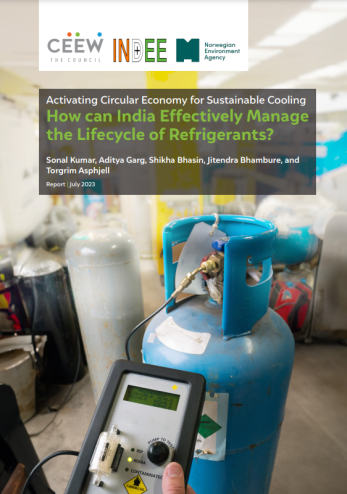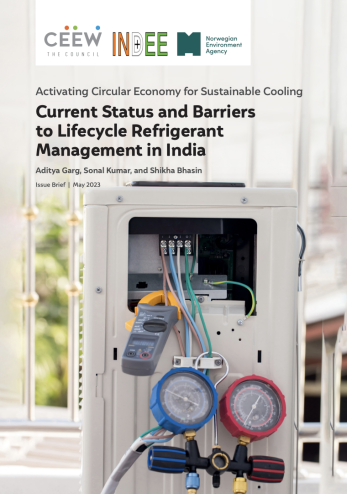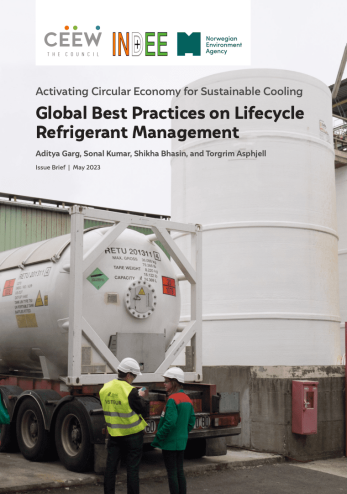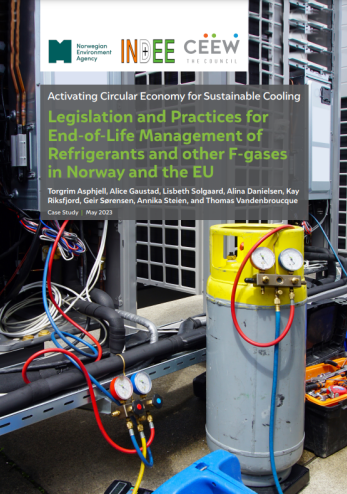



Suggested Citation: Bhasin, Shikha, Apurupa Gorthi, and Vaibhav Chaturvedi. 2021. Do Residential AC Buyers Prioritise Energy Efficiency? Indian Consumer Perception and Purchases. New Delhi: Council on Energy, Environment and Water.
This study, supported by the Shakti Sustainable Energy Foundation, documents AC end-users’ awareness about the implication of regular servicing with good servicing practices (GSPs) for energy efficiency. It identifies factors that influence their decision to purchase ACs in relation to star ratings. Further, the study proposes recommendations to enhance the uptake of energy efficient ACs as a purchase decision, and from an operations and maintenance point of view.
Residential air-conditioner (AC) penetration in India today is concentrated in metropolitan cities and accounts for a tremendous share of the current electricity used. This consumption by residential buildings is expected to rise substantially within the next decade, necessitating an energy optimisation strategy for India’s cooling needs. Further, the Kigali Amendment to the Montreal Protocol (2016) requires a refrigerant transition to lowglobal warming potential (GWP) alternatives, while increasing and optimising ACs’ energy efficiencies. Through this report, we aim to identify residential consumers’ understanding of AC energy efficiency as well as the factors that influence their decision to purchase ACs. Regular servicing and the adoption of good servicing practices (GSPs) have been recognised as an important aspect of maintaining AC energy efficiency during its operational lifetime. As a first step in this direction, this study aims to document end-users’ understanding of the impact of GSPs on servicing.
Given the focus on residential AC consumers, a door-to-door survey was conducted across four tier II Indian cities. For this, cities with a population of 10 lakh or more as per census data (2011) were classified into north, south, east, and west zones. One city from each zone was randomly picked, which resulted in Dhanbad, Madurai, Meerut, and Vadodara being surveyed. Within each city, six municipal wards, and three housing localities from each ward, were randomly picked. Six households from each locality were surveyed as a part of this study. This resulted in a sample of 108 households from each city and a total sample size of 432 households.
Of all the AC-owning households interviewed, over 75 per cent were aware of the star labelling programme. Among the households who reported being aware of the star labelling programme, 95 per cent deemed it trustworthy and 93 per cent claimed to find it useful. Given these positive perceptions and values associated with the programme, it is not surprising that most households (over 70 per cent) also wanted to purchase a high-star labelled AC. However, only 14 per cent actually went on to purchase a 4- or 5-star labelled AC. When asked about the reasons for this discrepancy between desire and purchase decisions, over 75 per cent of households attributed the cost of the AC as a barrier.
Energy star rating is among the top attributes considered during AC purchase, according to the majority of households. This was demonstrated by two key data points related to AC purchase decisions – information and attributes of the AC. It is interesting to qualify that on asking when these attributes were considered in relation to the timing of the purchase, i.e., well in advance of buying the AC or at the time of purchase, 68 per cent of the households reported that they considered energy efficiency a key attribute at the time of purchase, whereas relatively more respondents indicated that budgetary and branding decisions had been finalised well before the purchase was made.
While the above data has indicated fairly succinctly the significance that is attributed to energy efficiency when considering the purchase and use of an AC, it is telling that very few households see any explicit relationship between energy efficiency and AC usage practices. Only a third of households believed there to be any relationship between servicing and the maintenance of energy efficiency, while two-thirds of the household base reported being unaware (approximately 30 per cent) or not believing in a link between the two (over 40 per cent).
Given the potential for energy savings through high-efficiency purchases, as well as efficiency optimisation of AC units, this analysis identifies India specific challenges, and information lags to these ends in its AC consumer base. In order to tackle these, this report concludes by bringing out two sets of recommendations for: (i) enhancing financing solutions for higher efficiency AC purchases; and (ii) optimising efficiency through operations and maintenance (O&M) practices.
While it is commendable to note the awareness spread that the star labelling programme has achieved across appliance buyers even in India’s Tier II cities, when it comes to energy efficient ACs, the stark market reality betrays its accessibility given the high price points. Different financing platforms such as tax incentives, cumulative procurement programmes, as well as aggregating incentives across brands to encourage a more accessible price point for such units would be a direct area of intervention to scale up their sales, and contribute to a wider spread of higher efficiency appliances.
Furthermore, enhancing the narrative around energy efficiency as a purchase priority for consumers needs more attention. Data on electricity savings resulting from a higher efficiency AC, as well as its impacts on the local and global environment need to be brought out to the public in a simple targeted manner. Furthermore, the amount of possible savings as a result of a higher efficient AC purchase, and the impacts of regular servicing – on electricity savings and the life of the AC, for example – also need to be studied and targeted to the Indian consumer so that purchase decisions for higher efficiency products are not just well intentioned, but also well thought about.

Activating Circular Economy for Sustainable Cooling

Activating Circular Economy for Sustainable Cooling

Activating Circular Economy for Sustainable Cooling

Activating Circular Economy for Sustainable Cooling